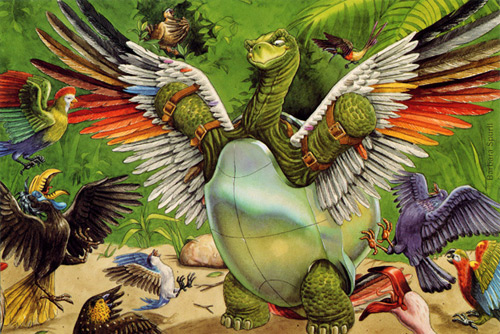While other birds use grass and tree branches to make nests, woodpeckers use their strong beaks to carve into tree trunks to make nests and catch insects.
1. Why don’t woodpeckers have headaches?
Pileated woodpeckers, the largest species in North America, smash their heads into tree trunks at a speed of 15 miles per hour, 20 times per second. So why don’t their heads fall to pieces?
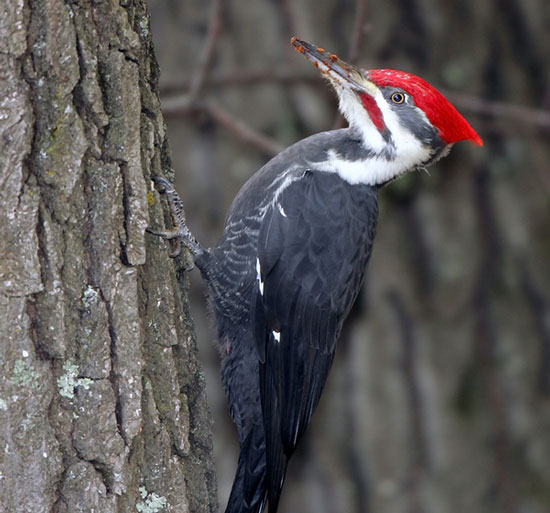
Firm muscles, a sponge-shaped skull , and thick eyelids keep their brains intact.
Professor Schwab’s research shows that woodpeckers can knock on hard surfaces up to 20 times a second with a force 1,200 times greater than gravity without suffering any shock, along with no damage to the retina or brain. Didn’t encounter any problems either.
“If you accidentally hit your head hard, you can break the blood vessels behind your eyes and damage the nerves in this area. Therefore, when I saw car accident victims and heard about the activities of woodpeckers, a big question occurred to me as to why injuries do not happen to these birds,” Schwab said. said.
Woodpeckers use straight, arrow-like knocks right at the tree trunk, helping to reduce feedback force and avoid causing shock to the head. In addition, this bird’s body is also designed with special details to minimize negative effects.
One millisecond before performing the knock, the dense muscles in the bird’s neck contract, while the eyelids close tightly, causing part of the force to be released to the neck muscles, helping to protect the skull from blows. crashed into the sky.
Compression bones in the skull fuse together to form a protective cushion. At the same time, tightly closed eyelids help woodpeckers protect their eyes from being hit by wood splinters and keep their pupils fixed – avoiding strong impacts that can knock or misalign the pupils.
“The eyelids act like seat belts in a car to keep the eyes from flying off the face. Otherwise, the acceleration force could tear the retina apart,” Schwab said. In addition, the very outside of the eye is also very strong and full of blood with the task of protecting the retina from being displaced.
The bird’s brain is very sturdy to be able to face consecutive head cuts. In humans, when experiencing head trauma, the brain will be bumped and shaken in the spinal fluid layer. However, woodpeckers do not have this fluid layer, reducing the risk of injury.
Along with straight arrow-like taps on tree trunks that help avoid shock to the head, the bird’s body is also designed to minimize impact. Milliseconds before the knock occurs, the dense muscle in the bird’s neck contracts and its eyelids close tightly. Some of the force is released to the muscles in the neck and protects the skull from a blow. Compression bones in the skull also provide a protective cushion. Meanwhile, the bird’s tightly closed eyelids protect the eye from any splinters of wood and keep the pupil in place.
“The eyelids act like a seat belt and keep the eyes from flying out of the face, ” Schwab says. ” Otherwise the acceleration force will tear the retina”. The outer part of the eye itself is also very strong and filled with blood to protect the retina from being jostled.
The bird’s brain is also very sturdy during such initial additions. Injuries to the head often cause the brain to bounce around in the spinal fluid layer. But woodpeckers have almost no liquid layer.
While scientists aren’t sure whether woodpeckers get headaches, Schwab points out that these birds at least have a good tolerance for pain. “When courting, male woodpeckers can drum up to 12,000 times a day. If they had to tell their lover, ‘Not tonight, honey, I have a headache,’ they wouldn’t be guilty. What makes that headache?
2. The tail has sharp spikes
Woodpeckers have the ability to climb trees and their bodies are flexible to adapt to life on tree trunks. Its tail has sharp spikes that stick into tree trunks. When a woodpecker uses its claws to firmly cling to a tree trunk, its tail acts as a third leg to help it cling firmly to the tree.
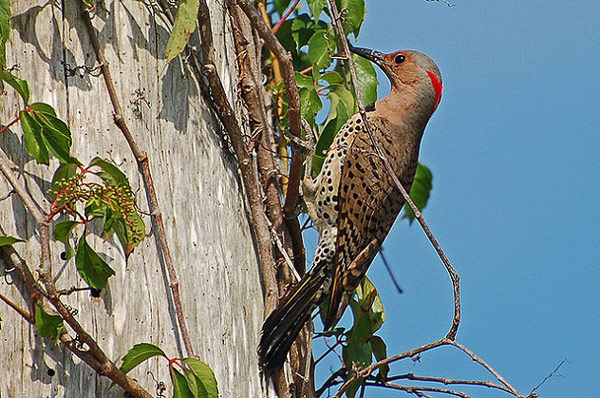
3. Smart and skillful
Most woodpecker species use their beaks to bore into tree trunks to catch insects or make nests, but acorn-eating woodpeckers in North and Central America have completely different characteristics. They make hundreds of small holes in tree trunks to store acorns and take them out for use when needed, especially in the cold winter.
4. Ground woodpecker
As the name suggests, ground woodpeckers often forage on the ground instead of in trees. They often live on savannas in South Africa, Swaziland and Lesotho.
They also have earthy colored fur to blend in with their surroundings. The main food of this bird is termites and other insects that live underground.
5. Climbing feet
Woodpeckers have zygodactyl feet, meaning two toes point forward and two toes point back. This feature makes it easy for them to perch firmly on tree trunks while catching prey as well as moving on the ground.
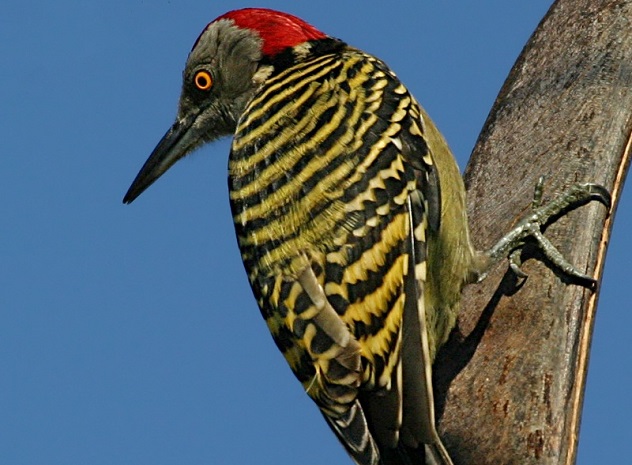
6. A symbiotic relationship with hummingbirds
Some woodpecker species in North America are closely related to hummingbirds. While woodpeckers bore into trees to catch insects, hummingbirds will fly after them to suck out the sap.
In return, hummingbirds are responsible for repelling larger birds that want to rob the sword-peckers of their feeding grounds. Hummingbirds usually suck nectar from flowers, but nectar resources are scarce in winter, forcing them to suck on tree sap as an alternative food.
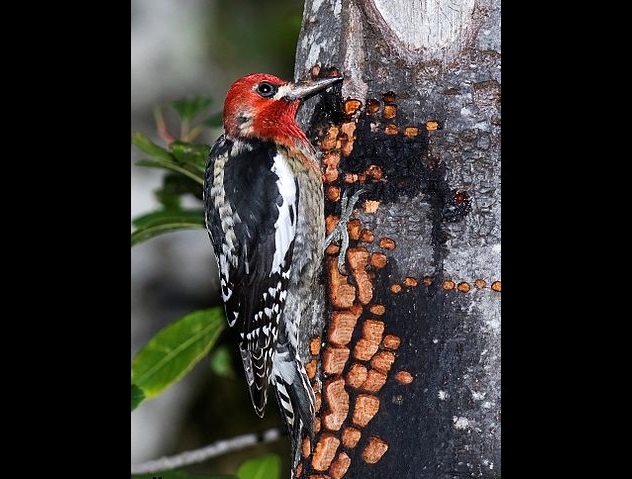
7. Gila Woodpecker
Living mainly in the desert regions of the southwestern United States and Mexico , Gila woodpeckers often eat insects on cacti. In addition, they eat cactus fruits and berries.
These birds play an important role in Saguaro cacti because they catch harmful insects and clean up damaged plant stems.
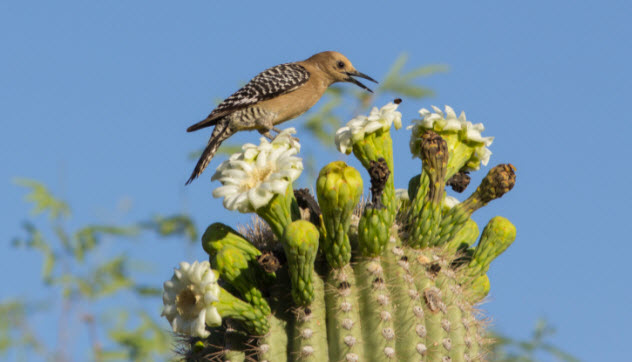
8. “Shield” protects against wood chips and sawdust
The woodpecker’s nose has layers of hard and soft feathers to help protect the nose from being damaged by wood chips and sawdust during the process of chiseling tree trunks.
The hard fur helps prevent foreign objects from entering the nostrils while the soft fur acts as a filter to block dust when they breathe. In addition, woodpeckers also have a special layer of feathers that protect their eyes.
9. Woodpeckers catch flies
Unlike other species of woodpeckers that often bore into tree trunks to catch insects, American fly-catching woodpeckers often hunt insects that fly in the air such as flies or land on tree trunks.
In fall and winter, they often eat acorns and other nuts. They also carve tree trunks to make nests like other woodpeckers.

10. Tortoiseshell bird
In the same family as woodpeckers, the Eurasian wry-necked bird has an external appearance more similar to that of a sparrow. Their necks are very flexible and can turn back like a snake.
The turtle-necked bird often nests in open forests and forages on the ground. Their favorite food is ants.
